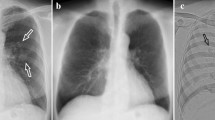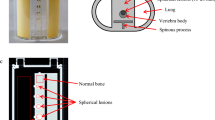Abstract
A sequential dual-energy subtraction technique for image-guided radiation therapy (IGRT) was developed. Here, we report on a computerized method for creating sequential soft-tissue images and the accuracy of tracking targets on the images obtained, in comparison to conventional fluoroscopic images. Two sets of sequential chest images during respiration of a normal subject were obtained with X-rays of different energy separately with a flat-panel detector (FPD). Sequential soft-tissue images were created from the two sets of sequential images consisting of real-time images and reference template images, respectively. The creation of sequential soft-tissue images consisted of three steps: one-to-one image correspondence of the two sequential images, image registration, and image subtraction in each frame. Motion tracking of lung vessels was then performed by the template-matching technique. For evaluation of the accuracy of motion tracking on the sequential soft-tissue images, the results were compared with those on the original sequential images. Sequential soft-tissue images provided more accurate tracking than the original images (P < 0.01). There was no significant error throughout all frames in the soft-tissue images, whereas the rib shadow introduced a tracking error in the original images. The maximum errors were 4.1 ± 0.3 mm in the sequential soft-tissue images and 28.1 ± 20.0 mm in the original images. In conclusion, sequential soft-tissue images were helpful for tracking of a target affected by respiratory motion. Dual-energy subtraction has the potential to improve the accuracy of IGRT without implanted markers.





Similar content being viewed by others
References
Keall PJ, Mageras GS, Balter JM, Emery RS, Forster KM, Jiang SB et al. The management of respiratory motion in radiation oncology report of AAPM Task Group 76. Med Phys. 2006;33:3874–900.
Giraud P, Yorke E, Ford EC, Wagman R, Mageras GS, Amols H et al. Reduction of organ motion in lung tumors with respiratory gating. Lung Cancer. 2006;51:41–51.
Wong JW, Sharpe MB, Jaffray DA, Kini VR, Robertson JM, Stromberg JS et al. The use of active breathing control (ABC) to reduce margin for breathing motion. Int J Radiat Oncol Biol Phys. 1999;44:911–9.
Cheung PC, Sixel KE, Tirona R, Ung YC. Reproducibility of lung tumor position and reduction of lung mass within the planning target volume using active breathing control (ABC). Int J Radiat Oncol Biol Phys. 2003;57:1437–42.
Berbeco RI, Nishioka S, Shirato H, Chen GT, Jiang SB. Residual motion of lung tumours in gated radiotherapy with external respiratory surrogates. Phys Med Biol. 2003;50:3655–67.
Chen QS, Weinhous MS, Deibel FC, Ciezki JP, Macklis RM. Fluoroscopic study of tumor motion due to breathing: facilitating precise radiation therapy for lung cancer patients. Med Phys. 2001;28:1850–6.
Seppenwoolde Y, Shirato H, Kitamura K, Shimizu S, van Herk M, Lebesque JV et al. Precise and real-time measurement of 3D tumor motion in lung due to breathing and heartbeat, measured during radiotherapy. Int J Radiat Oncol Biol Phys. 2002;53:822–34.
Neicu T, Berbeco R, Wolfgang J, Jiang SB. Synchronized moving aperture radiation therapy (SMART): improvement of breathing pattern reproducibility using respiratory coaching. Phys Med Biol. 2006;51:617–36.
McBain CA, Henry AM, Sykes J, Amer A, Marchant T, Moore CM et al. X-ray volumetric imaging in image-guided radiotherapy: the new standard in on-treatment imaging. Int J Radiat Oncol Biol Phys. 2006;64:625–34.
Van der Geld YG, Lagerwaard FJ, van Sornsen de Koste JR, Cuijpers JP, Slotman BJ, Senan S. Reproducibility of target volumes generated using uncoached 4-dimensional CT scans for peripheral lung cancer. Radiat Oncol. 2006;1:43.
Rietzel E, Liu AK, Doppke KP, Wolfgang JA, Chen AB, Chen GT et al. Design of 4D treatment planning target volumes. Int J Radiat Oncol Biol Phys. 2006;66:287–95.
Tanaka R, Sanada S, Suzuki M, Matsui T, Uoyama Y. New screening chest radiography with computer analysis of pulmonary marking movement and change in regional density. Jpn J Radiol Technol. 2002;58:1489–96.
Tanaka R, Sanada S, Kobayashi T, Suzuki M, Matsui T, Matsui O. Computerized methods for determining respiratory phase on dynamic chest radiographs obtained by a dynamic flat-panel detector (FPD) system. J Digit Imaging. 2006;19:41–51.
Kido S, Ikezoe J, Naito H, Tamura S, Kozuka T, Ito W et al. Single-exposure dual-energy chest images with computed radiography. Evaluation with simulated pulmonary nodules. Invest Radiol. 1993;28:482–7.
Ito W, Shimura K, Nakajima N, Ishida M, Kato H. Improvement of detection in computed radiography by new single-exposure dual-energy subtraction. J Digit Imaging. 1993;6:42–7.
Fraser RG, Hickey NM, Niklason LT, Sabbagh EA, Luna RF, Alexander CB et al. Calcification in pulmonary nodules: detection with dual-energy digital radiography. Radiology. 1986;160:595–601.
Niklason LT, Hickey NM, Chakraborty DP, Sabbagh EA, Yester MV, Fraser RG et al. Simulated pulmonary nodules: detection with dual-energy digital versus conventional radiography. Radiology. 1986;160:589–93.
Xu T, Ducote JL, Wong JT, Molloi S. Feasibility of real time dual-energy imaging based on a flat panel detector for coronary artery calcium quantification. Med Phys. 2006;33:1612–22.
International basic safety standards for protection aginst ionizing radiation and for the safety of radiation sources. Vienna: International Atomic Energy Agency (IAEA); 1996.
Hajnal JV, Hill Derek LG, Hawkes DJ. Medical Image Registration. Boca Raton: CRC Press; 2001.
Too TS. Insight into images. Wellesley: A K Peters Ltd; 2004.
Kuhlman JE, Collins J, Brooks GN, Yandow DR, Broderick LS. Dual-energy subtraction chest radiography: what to look for beyond calcified nodules. Radiographics. 2006;26:79–92.
Ballard DH, Brown CM. Computer vision. Englewood Cliffs: Prentice-Hall; 1982.
Ishida T, Katsuragawa S, Nakamura K, MacMahon H, Doi K. Iterative image warping technique for temporal subtraction of sequential chest radiographs to detect interval change. Med Phys. 1999;26:1320–9.
Acknowledgments
This work was supported in part by a Grant-in-Aid for Scientific Research from the Japanese Ministry of Education, Culture, Sports, Science, and Technology, and the Konica Minolta Imaging Science Foundation. The authors thank the technologists of the Department of Radiology, Kanazawa University Hospital, who assisted with data acquisition, and Dr Shinichiro Mori at the National Institute of Radiological Sciences for valuable discussions regarding technical and clinical feasibility. The authors thank the editors and reviewers who spent time giving us informative advice to improve our manuscript.
Author information
Authors and Affiliations
Corresponding author
About this article
Cite this article
Tanaka, R., Sanada, S., Matsui, T. et al. Sequential dual-energy subtraction technique with a dynamic flat-panel detector (FPD): primary study for image-guided radiation therapy (IGRT). Radiol Phys Technol 1, 144–150 (2008). https://doi.org/10.1007/s12194-008-0021-6
Received:
Revised:
Accepted:
Published:
Issue Date:
DOI: https://doi.org/10.1007/s12194-008-0021-6




